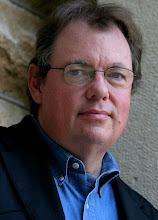Wednesday, March 3, 2010
Dead like Doolin
Today, Doolin's grave is marked with an impressive red tombstone that is about as tall as I am (see left), in an area marked with a cheesy "Boot Hill" sign in Summit View. By all accounts, Doolin was among the most likeable of western outlaws, and claimed to have never killed anybody during any of his many robberies, at least not on purpose.
Tuesday, December 29, 2009
Territorial prison gallery
Wide shot
Here's a shot of the entire building. The old entrance is on the left (west) side of this photo, facing west. The original prison building did not have a green peaked roof, nor did it have the church-like addition on the east side.
Here's what the territorial jail originally looked like in the 1890s, from a photo in the Oklahoma Historical Society Archives. Look closely and you can see the steps leading up to the iron cage and main entrance on the second floor.
Here's a tiny barred window that is on the ground floor of the prison, visible on the old photo just above the bottom of the steps. This was a special cell sometimes used for female prisoners, usually prostitutes, if I'm reading my sources correctly.
Did I encounter any ghosts while visiting the old territorial prison? Well, no. But there was a decidedly weird and malevolent vibe to the place -- but maybe that's just because I knew a little history. Oh, and what happened to Bill Doolin, the famous Oklahoma Territory outlaw who famously broke out in 1896? I'll save that story for my next post...
Friday, December 11, 2009
Holiday shooter
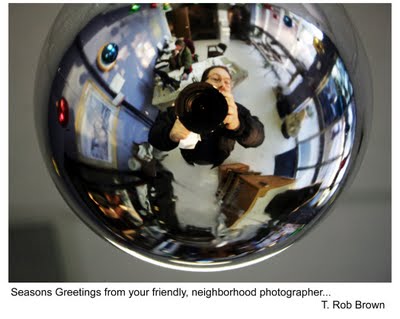 Here's something that made me smile, even though I hate this time of year (I know, I know, call me Scrooge). It's a holiday self-portrait from T. Rob Brown, my friend and former colleague at The Joplin Globe. I worked with Brown for many years at the Globe, and he often accompanied me on several investigative pieces. He was named AP Photographer of the Year for 2009. The holiday greeting wasn't taken with a fisheye, by the way -- it's his reflection in a Christmas ornament.
Here's something that made me smile, even though I hate this time of year (I know, I know, call me Scrooge). It's a holiday self-portrait from T. Rob Brown, my friend and former colleague at The Joplin Globe. I worked with Brown for many years at the Globe, and he often accompanied me on several investigative pieces. He was named AP Photographer of the Year for 2009. The holiday greeting wasn't taken with a fisheye, by the way -- it's his reflection in a Christmas ornament.
Wednesday, December 9, 2009
All in the lead
Wednesday, November 11, 2009
Time, Date, Twitter
Tuesday, October 27, 2009
Pedestrian Comics
 I seem to be blogging a lot, probably to keep from writing. Well, here's something I've been meaning to post for a while now -- Pedestrian Comics by Dan Spees. It's an autobiographical take on his life teaching community college at Hutchinson, Kansas. I particularly like the panels where he is sent to teach composition at a local Catholic school.
I seem to be blogging a lot, probably to keep from writing. Well, here's something I've been meaning to post for a while now -- Pedestrian Comics by Dan Spees. It's an autobiographical take on his life teaching community college at Hutchinson, Kansas. I particularly like the panels where he is sent to teach composition at a local Catholic school.
Monday, October 26, 2009
A Remarkable Ego
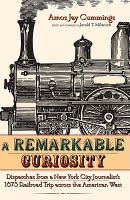 Here's a book review I did for the Spring 2009 issue of The Great Plains Newsletter. This post is way too long, according to the blog gurus, but to hell with them. The newsletter isn't available online, so thought I'd offer it here.
Here's a book review I did for the Spring 2009 issue of The Great Plains Newsletter. This post is way too long, according to the blog gurus, but to hell with them. The newsletter isn't available online, so thought I'd offer it here.A Remarkable Curiosity: Dispatches from a New York City Journalist's 1873 Railroad Trip Across the American West. Edited and compiled by Jerald T. Milanich. Boulder: The UP of Colorado, 2008, 371 pages, with index and illustrations.
Although few have heard of him now, Amos Jay Cummings was once the most popular journalist in the United States. More than a hundred years after his death, dispatches from his 1873 railway journey across the American west have been collected by anthropologist Jerald T. Milanich.
Milanich, curator of archaeology at the Florida Museumof Natural History at Gainesville, became interested in Cummings when he read an unsigned newspaper account of a visit to Turtle Mound, a huge shell heap left by ancient Indians on the Atlantic coast. Intrigued, Malevich found phraseology similar to the Turtle Mound article in an 1875 guidebook to Florida that was authored by “Ziska,” an obvious pseudonym.
After what Malevich describes as a “wild literary adventure,” he confirmed that Ziska was in fact Amos J. Cummings – journalist, Civil War hero, and Congressman.
And, one might add, liar and shameless self-promoter.
Cummings was born in 1838 in a small town near border between Pennsylvania and New York. He claimed to have run away at 15 to become an “itinerant typesetter,” although this is certainly an exaggeration, a stretcher told by Cummings in his later years to make his life seem more romantic. He also claimed to have accompanied William Walker during the 1858 invasion of Nicaragua, but Malevich is rightly suspicious – neither the dates nor the details add up to allow Cummings to have been with Walker during any of his ill-fated attempts to establish a slave-holding Southern empire in Latin America.
During the Civil War, Cummings was a volunteer with a New Jersey infantry regiment, and saw action at Fredericksburg and Chancellorsville. Thirty years after the war – and following his election to Congress – he received the Medal of Honor for leading a charge to save a Union gun from falling into rebel hands during the battle of Salem Church on May 4, 1863.
Milanich concludes that Cummings was a “bona fide war hero” because about a third of the 35 New Jersey soldiers who were awarded the medal got theirs long after the war, too. But the most complete account of the feat of heroism that saved the cannon appears to have penned by – you guessed it – Cummings himself.
“One thing I soon learned,” Milanich writes in a classic bit of understatement, “was that Cummings and his biographers did not always provide correct or truthful information.”
The stretchers include moving his year of birth to 1841, apparently to make Cummings appear younger. The reason, Milanich, believes, was vanity. After his success as a travel writer sending back anonymous dispatches from wild and wooly Florida, Cummings (who was managing editor of The New York Sun) undertook the six-month railway journey to the west. It was during this journey that he began filing his dispatches under Ziska.
Alas, Milanich never discovered why Cummings chose the odd pseudonym.
“I’ve been trying to figure it out since I first discovered that Ziska was Cummings,” Milanich said in an email message. “Had I been a reasonably literate person in 1873 I probably would know immediately, but.. . .”
While such affected journalistic handles were common during the period, Ziska no longer rings like the pen name of one of his travel writing contemporaries, Mark Twain. His prose pales in comparison as well, which may be much of the reason Cummings is forgotten and Twain is not. To say that his style is dry is like saying that rain is wet.
“The trip by railroad over the plains is monotonous,” Cummings reports from Kansas. “It is generally understood that passengers have not a thing to do during the journey but to gaze at immense buffalo herds and shoot antelopes.
Although it was in the buffalo season, I saw none of the animals.”
Still, there is much historical value in his accounts. The best example may be an interview Cummings did in July 1873 at Salt Lake City with Brigham Young. The 78-year-old patriarch was being sued for divorce and $200,000 by his seventeenth wife, Ann Eliza.
“I had a talk with the Mormon Prophet yesterday,” Cummings begins, and goes on to provide a detailed account of his reception: “I saw the great Religious Chief sitting on a sofa before I entered the room. I recognized him from the pictures that I had seen hanging at the doors of the Salt Lake photograph galleries. He was looking toward the stoop, and evidently expecting me. He kept his eyes fixed upon me as I approached, then he arose, shook hands, politely offered me his seat upon the sofa, and sat down upon a chair at my side.”
A sort of transcript follows, and when Cummings asks about the divorce suit, Young explodes.
“Blackmail! Blackmail! It is not the first time they have attempted to Blackmail the Mormon Church, and I presume it will not be the last. We have never allowed them to blackmail us out of a single cent, and we don’t propose to allow them to do so now.”
A day later, he interviewed Ann Eliza Young. During the long session, he asked the 30-year-old woman why she thought Young had acquired so many wives.
“Well, we (meaning she and the other wives) think it’s vanity. He just wants to show that if he is an old man he can marry young women; and he isn’t the only one in power who does the same thing.”
About a third of the dispatches are devoted to the divorce and other Mormon issues, apparently to feed the growing American fascination with the polygamous desert sect. The remaining articles are mostly sketches of the colorful characters that Cummings met on his curious journey to San Francisco. In one, he describes a winter storm from the point of view of a rancher along Gypsum Creek in central Kansas:
“A night’s ride in a hard norther, fifty vain endeavors to get the cattle turned against the wind, and then daylight. You find you are on the banks of the Arkansas River, and have lost some twenty or thirty animals. You are cold, frost bitten, hungry, and want to sit down and die. That is Kansas winter.”
Before Cummings left San Francisco on Nov. 4, 1873, he wrote the article that would appear in The San Francisco Chronicle announcing his departure. In it, he describes himself as “an accomplished angler as well as a brilliant and vivacious writer.”
While Cummings makes a modern journalist uncomfortable with his megalomania and casual grip on the truth, his contribution to reporting – and to history – is undeniable. Milanich has rightly restored Cummings to public consumption. He plans a follow-up volume, one dealing with Cummings and his connection to Thomas Edison – it was Cummings, through his pieces in The New York Sun, that first brought the inventor to national attention, when Edison was searching for a suitably durable filament during the invention of the light bulb.
Sunday, October 25, 2009
Writing Western Noir
 At 2:30 p.m. Sunday, Nov. 1, I'll be speaking at the Alford Branch Library in Wichita. My topic is "Writing Western Noir" and I'll tell the wicked but true story of how I went from Front Page Detective to HELLFIRE CANYON -- and won the Spur and a Kansas Notable Book Award along the way. The program is part of Western Days at the Wichita Public Library system. My colleague Jim Hoy is also doing a presentation on Flint Hills Cowboys Nov. 16 at the Alford branch.
At 2:30 p.m. Sunday, Nov. 1, I'll be speaking at the Alford Branch Library in Wichita. My topic is "Writing Western Noir" and I'll tell the wicked but true story of how I went from Front Page Detective to HELLFIRE CANYON -- and won the Spur and a Kansas Notable Book Award along the way. The program is part of Western Days at the Wichita Public Library system. My colleague Jim Hoy is also doing a presentation on Flint Hills Cowboys Nov. 16 at the Alford branch.
Monday, October 12, 2009
Seven Secrets at KAC
 This Saturday, I'll be the keynote speaker at the Kansas Authors Club annual convention in Topeka.
This Saturday, I'll be the keynote speaker at the Kansas Authors Club annual convention in Topeka.I'm doing a workshop on The Hero's Journey at 3:30. At 6 p.m., I'm presenting the keynote, "The Seven Secrets of Writing Well." The conference is being held at the Capitol Plaza Hotel and Convention Center, 1717 SW Topeka Blvd.
Other speakers include Kansas Poet Laureat Denise Low; Thomas Fox Averill, who is writer-in-residence at Washburn University; and Mark Bouton, a mystery author and former FBI agent. There's also a flashlight tour of the state capitol on Friday night.
QUANTRILL, again
You can find Patsy's blog here.
Tuesday, August 25, 2009
DIABLO cover
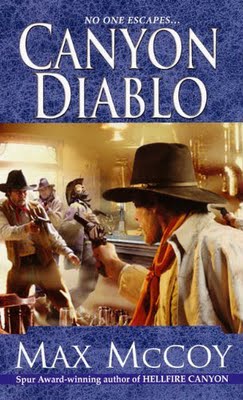 Here's a glimpse of the cover for CANYON DIABLO, which will be released in February by Kensington. I don't hate it. If you squint just right it could be a scene from the book. That might be a a .36-caliber Manhattan revolver in Jacob Gamble's hand, during a fight in a Tombstone saloon. Also, the third (and last) book of the trilogy is scheduled to appear in September 2010. The title? DAMNATION ROAD.
Here's a glimpse of the cover for CANYON DIABLO, which will be released in February by Kensington. I don't hate it. If you squint just right it could be a scene from the book. That might be a a .36-caliber Manhattan revolver in Jacob Gamble's hand, during a fight in a Tombstone saloon. Also, the third (and last) book of the trilogy is scheduled to appear in September 2010. The title? DAMNATION ROAD.
Sunday, July 26, 2009
I, QUANTRILL revisited
Here's a review from Tome of the Uknown Blogger:
I have previously admitted to a fondness for old western novels written by Louis L’Amour. Although I have read a handful of other authors, I just haven’t found a single writer that could hold my attention. Until now.
I had been looking to sign a certain paperback copy of Louis L’Amour’s “Bad Medicine” out of the bookmobile again in order to write a little piece about it here. I wasn’t having much luck, but week after week I was seeing this book, titled “I, Quantrill." On a whim I signed it out. I’d never heard of Max McCoy before, and was interested to learn he was from Kansas and that he has a penchant for the Ozarks in Missouri and Arkansas.
“I, Quantrill” was an excellent book. Well written with characters who seemed almost to live and breathe, I think, due to the details revealed about them.
Here's the full review. He's forgiven for having never heard of me. Check out the blog -- the UB writes powerfully about losing his wife, Shelley, to cancer. Perhaps that is one reason he connected with the melancholy tone of I, QUANTRILL.
Monday, July 20, 2009
Tuesday, July 7, 2009
Flint Hills Bee
Monday, May 18, 2009
Back in the saddle
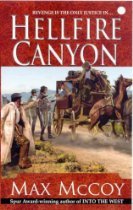 I'm back. CANYON DIABLO, the sequel to HELLFIRE CANYON, has been delivered. I don't know if it's better than original, but it sure as hell is bigger. It took me twice as long to write it as I thought it would. This one takes Jacob Gamble into Arizona Territory in the 1880s. My editor, Gary Goldstein, helped me scout locations on the way to last year's Western Writers of America convention at Scottsdale.
I'm back. CANYON DIABLO, the sequel to HELLFIRE CANYON, has been delivered. I don't know if it's better than original, but it sure as hell is bigger. It took me twice as long to write it as I thought it would. This one takes Jacob Gamble into Arizona Territory in the 1880s. My editor, Gary Goldstein, helped me scout locations on the way to last year's Western Writers of America convention at Scottsdale.In other news, I, QUANTRILL has been named a finalist for this year's Spur Award. At least I get a lunch out of it, next month at the Western Writers of America annual convention -- this year it's in Oklahoma City.
Also, here's a review of HELLFIRE CANYON from the Kansas Notable Book Committee:
Alf Bolin was a real person. An article by Vickie Hooper of Forsyth, Missouri, stated, “During the Civil War in Taney and Ozark Counties in southern Missouri, he was the cruelest man alive.” So when I picked up a copy of Hellfire Canyon by Max McCoy, I expected to read a bloody account of Alf’s escapades.
Instead, I was surprised by the touching tale of a young boy who endured sights, sounds and events that no child should ever have to experience. The book brings back familiar memories of Little Big Man telling his story.
The author, Max McCoy, begins the telling of one viewpoint of Alf’s tale by having the young boy who could have been Alf’s victim speak for himself to a reporter in a fairly modern-day bar. Alf becomes Jacob Gamble’s mentor. Jacob is a 12-year-old fiddle player who finds himself needing a “protector” and Alf fits the bill. He learns from the “expert” when it comes to cruel acts. Yet, Jacob maintains some of the tender heart he glimpsed occasionally from his Mother.
Do not misunderstand me. There is violence and it is bloody, but the story would not be as moving — you would really not to be able to feel what Jacob felt without the horror of Alf’s actions and his overall meanness.
Hellfire Canyon has now been awarded the Spur Award. As an avid reader who doesn’t usually read Westerns, I almost missed this one. Don’t let the paperback cover fool you; this is not just another cowboy story.
Monday, December 22, 2008
See you next year
Sunday, November 23, 2008
Moon Pool unabridged audio book
 It was a week for surprises.
It was a week for surprises.THE MOON POOL, my 2004 thriller from Leisure, has just been released as an 11-hour unabridged book on tape by Books In Motion. I know, because it's on their website under "Just in."
So, for $57.95 you can buy the CD Library Package. Or, you can rent it for $9.95 or own it as an MP3 download for $14.95. Also, I can't resist the urge to point out that you could have owned the original paperback for seven bucks. But then, you wouldn't be able to listen to it in the car, would you?
As I've lamented before, the author is always the last to know. Seems like some money should have shown up at my door in connection with this. Guess I'll make some calls.
At least the cover is cool.

